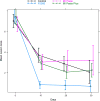Remineralization effect of CPP-ACP and fluoride for white spot lesions in vitro
- PMID: 25260438
- PMCID: PMC5551488
- DOI: 10.1016/j.jdent.2014.09.004
Remineralization effect of CPP-ACP and fluoride for white spot lesions in vitro
Abstract
Objectives: This in vitro study compared the remineralization effect on white spot lesions of casein phosphopeptide-amorphous calcium phosphate crème, or CPP-ACP (MI Paste™), 1.1% NaF dentifrice containing 5000ppm of fluoride (ControlRX™), or CPP-ACP crème with 900ppm of fluoride (MI Paste Plus™) with that of a control.
Methods: Artificial white spot lesions were created on smooth enamel surfaces of sound molars using a previously reported demineralization model. Specimens were randomly assigned to four treatments (n=35) with a pH-cycling model over 30 days: Control (no treatment); MI Paste (10% CPP-ACP crème); F5000 (1.1% NaF dentifrice); or MI Paste Plus (10% CPP-ACP plus 900ppm fluoride crème). Products were applied following manufacturers' directions. Changes in mean lesion depth expressed by percent fluorescence loss (ΔF%), and lesion area (mm(2)) from baseline to after treatment were measured with light-induced fluorescence (QLF). Mean values of each parameter were compared between groups (p<0.05).
Results: The remineralization pattern for the F5000 group was unique with marked initial remineralization during the first 10 days and little subsequent change. Based on mean lesion area, the F5000 demonstrated greater remineralization than Control, MI Paste and MI Paste Plus groups. Based on mean fluorescence loss, the F5000 group showed improved remineralization relative to MI Paste Plus, but did not differ statistically from the Control at the end of 30 days.
Conclusions: The 1.1% NaF dentifrice demonstrated overall greater remineralization ability than 10% CPP-ACP crème. However, the 1.1% NaF dentifrice was only as effective as the Control to reduce fluorescence loss.
Clinical significance: This study showed that a 1.1% NaF dentifrice (5000ppm) demonstrated greater remineralization ability than the CPP-ACP topical tooth crème and that the addition of fluoride to its formulation seems to enhance remineralization. Saliva also has the ability to exert an important remineralization effect over time.
Keywords: CPP-ACP; Fluoride; QLF; Remineralization; White spot lesions.
Copyright © 2014 Elsevier Ltd. All rights reserved.
Figures





Similar articles
-
Comparison of the newer preventive therapies on remineralisation of enamel in vitro.J Dent. 2017 Nov;66:37-44. doi: 10.1016/j.jdent.2017.08.013. Epub 2017 Aug 30. J Dent. 2017. PMID: 28859965
-
In vitro remineralization of enamel subsurface lesions and assessment of dentine tubule occlusion from NaF dentifrices with and without calcium.J Indian Soc Pedod Prev Dent. 2013 Jan-Mar;31(1):29-35. doi: 10.4103/0970-4388.112403. J Indian Soc Pedod Prev Dent. 2013. PMID: 23727740 Clinical Trial.
-
Effects of Fluoride-containing Biomimetic Agents on Remineralization and Color Change of Enamel White Spot Lesions: An In Vitro Study.Oper Dent. 2025 Jan 1;50(1):78-92. doi: 10.2341/24-048. Oper Dent. 2025. PMID: 39601685
-
Anticariogenicity of casein phosphopeptide-amorphous calcium phosphate: a review of the literature.J Contemp Dent Pract. 2009 May 1;10(3):1-9. J Contemp Dent Pract. 2009. PMID: 19430620 Review.
-
Evaluation of the efficacy of casein phosphopeptide-amorphous calcium phosphate on remineralization of white spot lesions in vitro and clinical research: a systematic review and meta-analysis.BMC Oral Health. 2019 Dec 30;19(1):295. doi: 10.1186/s12903-019-0977-0. BMC Oral Health. 2019. PMID: 31888600 Free PMC article.
Cited by
-
Effect of Two Methods of Remineralization and Resin Infiltration on Surface Hardness of Artificially Induced Enamel Lesions.J Dent (Shiraz). 2020 Mar;21(1):12-17. doi: 10.30476/DENTJODS.2019.77864. J Dent (Shiraz). 2020. PMID: 32158780 Free PMC article.
-
Nanoparticles as Anti-Microbial, Anti-Inflammatory, and Remineralizing Agents in Oral Care Cosmetics: A Review of the Current Situation.Nanomaterials (Basel). 2020 Jan 13;10(1):140. doi: 10.3390/nano10010140. Nanomaterials (Basel). 2020. PMID: 31941021 Free PMC article. Review.
-
Application of Amorphous Calcium Phosphate Agents in the Prevention and Treatment of Enamel Demineralization.Front Bioeng Biotechnol. 2022 May 13;10:853436. doi: 10.3389/fbioe.2022.853436. eCollection 2022. Front Bioeng Biotechnol. 2022. PMID: 35646855 Free PMC article. Review.
-
In vitro and in vivo evaluation of electrophoresis-aided casein phosphopeptide-amorphous calcium phosphate remineralisation system on pH-cycling and acid-etching demineralised enamel.Sci Rep. 2018 Jun 11;8(1):8904. doi: 10.1038/s41598-018-27304-5. Sci Rep. 2018. PMID: 29891861 Free PMC article.
-
Quantitative Analysis of Remineralization of Artificial Carious Lesions with Commercially Available Newer Remineralizing Agents Using SEM-EDX- In Vitro Study".J Clin Diagn Res. 2017 Apr;11(4):ZC20-ZC23. doi: 10.7860/JCDR/2017/22270.9642. Epub 2017 Apr 1. J Clin Diagn Res. 2017. PMID: 28571254 Free PMC article.
References
-
- Featherstone JD. Caries prevention and reversal based on the caries balance. Pediatr Dent. 2006;28(2):128–32. discussion 92-8. - PubMed
-
- Backer Dirks O. Posteruptive changes in dental enamel. Journal of Dental Research. 1966;45:503–11.
-
- Silverstone LM. Remineralization phenomena. Caries Res. 1977;11(Suppl 1):59–84. - PubMed
-
- Hicks J, Flaitz C. Role of remineralizing fluid in in vitro enamel caries formation and progression. Quintessence Int. 2007;38(4):313–9. - PubMed
-
- Featherstone JD, Behrman JM, Bell JE. Effect of whole saliva components on enamel demineralization in vitro. Crit Rev Oral Biol Med. 1993;4(3–4):357–62. - PubMed
Publication types
MeSH terms
Substances
Grants and funding
LinkOut - more resources
Full Text Sources
Other Literature Sources
Medical

